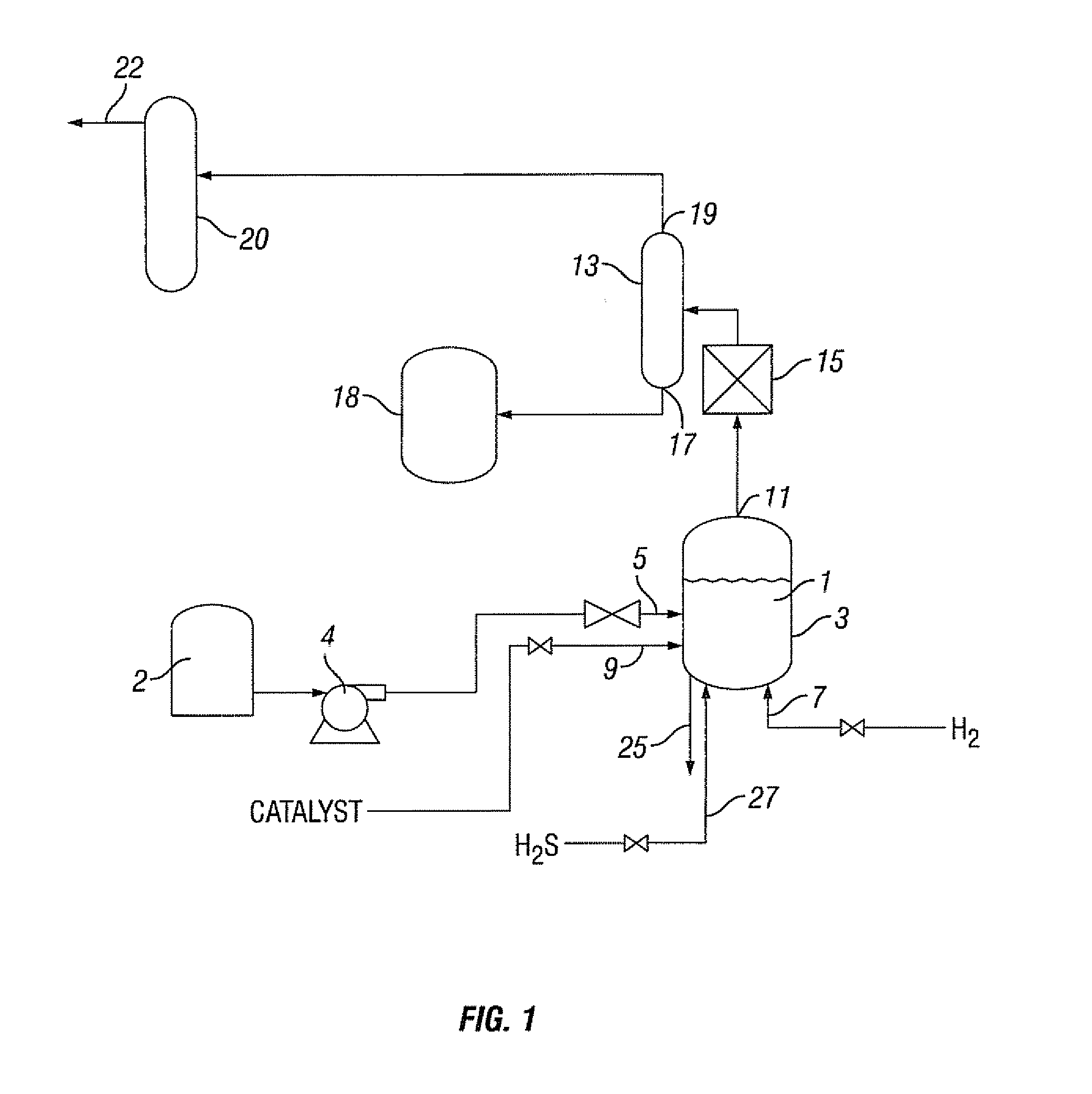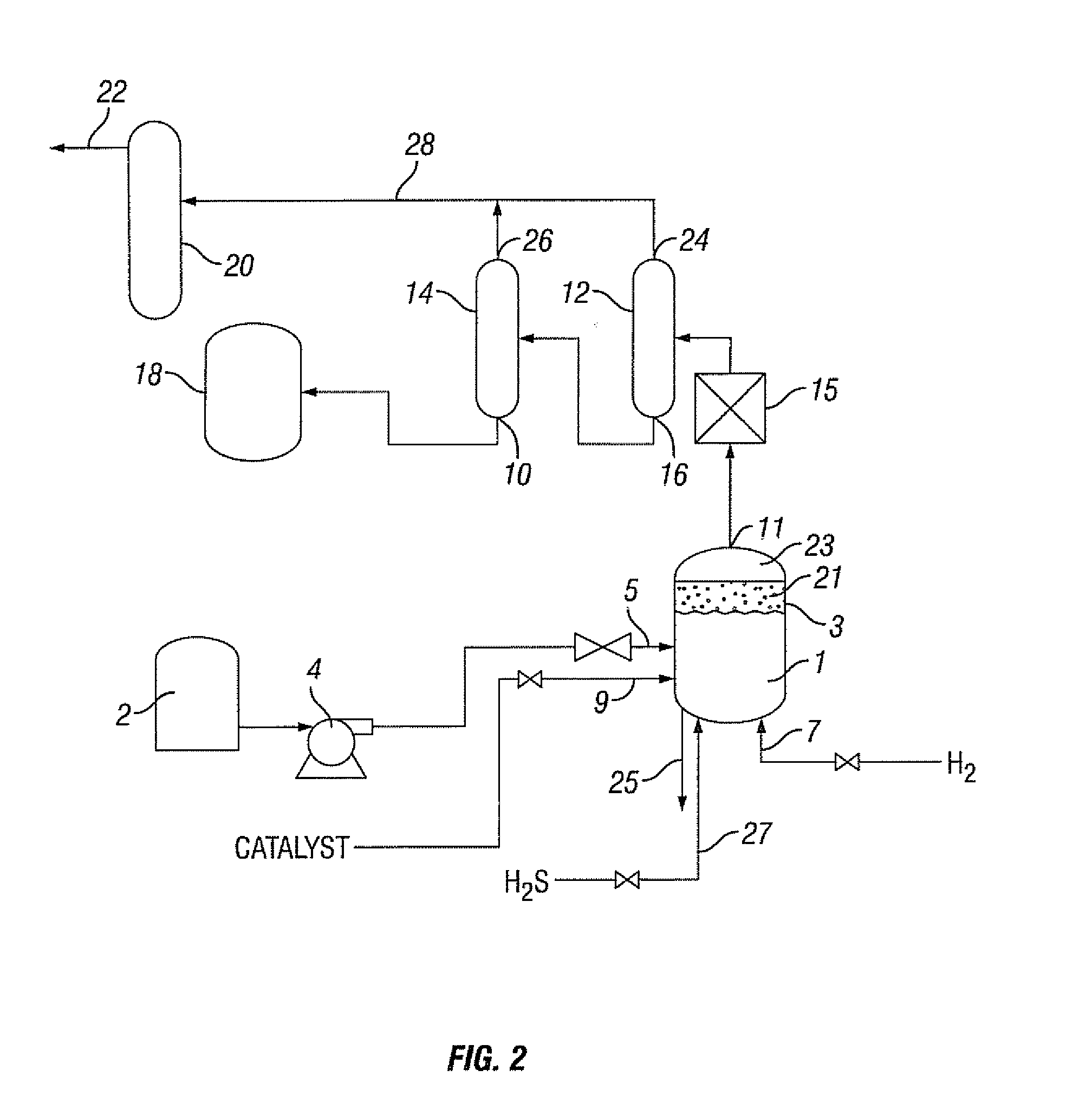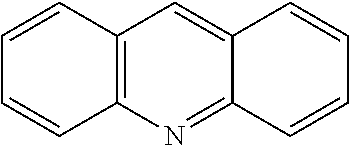Hydrocarbon composition
a technology of hydrocarbons and compositions, applied in the field of hydrocarbon compositions, can solve the problems of disadvantaged crudes that typically require a considerable amount of upgrading, high molecular weight sulfur containing heteratomic hydrocarbons, and disadvantaged resources
- Summary
- Abstract
- Description
- Claims
- Application Information
AI Technical Summary
Benefits of technology
Problems solved by technology
Method used
Image
Examples
example 1
[0124]A catalyst for use in a process to form the composition of the present invention containing copper, molybdenum, and sulfur was produced, where at least a portion of the catalyst had a structure according to Formula (X).
[0125]A 22-liter round-bottom flask was charged with a solution of 1199 grams of copper sulfate (CuSO4) in 2 liters of water. The copper sulfate solution was heated to 85° C. 520.6 grams of ammonium tetrathiomolybdate (ATTM) {(NH4)2(MoS4)} in 13 liters of water was injected into the heated copper sulfate solution through an injection nozzle over a period of 4 hours while stirring the solution. After the addition was complete, the solution was stirred for 8 hours at 93° C. and then was allowed to cool and settle overnight.
[0126]Solids were then separated from the slurry. Separation of the slurry was accomplished using a centrifuge separator @ 12,000 Gauss to give a red paste. The separated solids were washed with water until conductivity measurements of the efflu...
example 2
[0128]Bitumen from Peace River, Canada was selected as a hydrocarbon-containing feedstock for cracking. The Peace River bitumen was analyzed to determine its composition. The properties of the Peace River bitumen are set forth in Table 1:
TABLE 1PropertyValueHydrogen (wt. %)10.1Carbon (wt. %)82Oxygen (wt. %)0.62Nitrogen (wt. %)0.37Sulfur (wt. %)6.69Nickel (wppm)70Vanadium (wppm)205Microcarbon residue (wt. %)12.5C5 asphaltenes (wt. %)10.9Density (g / ml)1.01Viscosity at 38° C. (cSt)8357TAN-E (ASTM D664) (mg KOH / g)3.91Boiling Range DistributionInitial Boiling Point-204° C. (400° F.)(wt. %) [Naphtha]0204° C. (400° F.)-260° C. (500° F.) (wt. %) [Kerosene]1260° C. (500° F.)-343° C. (650° F.) (wt. %) [Diesel]14343° C. (650° F.)-538° C. (1000° F.) (wt. %) [VGO]37.5>538° C. (1000° F.) (wt. %) [Residue]47.5
[0129]Six samples of the Peace River bitumen were separately hydrocracked by mixing each bitumen sample with the catalyst prepared in Example 1, hydrogen, and hydrogen sulfide. The bitumen sa...
example 3
[0134]Another catalyst for use in a process to form the composition of the present invention containing copper, molybdenum, and sulfur was produced, where at least a portion of the catalyst had a structure according to Formula (X).
[0135]A 22-liter round-bottom flask was charged with 520 grams of ammonium tetrathiomolybdate (ATTM) {(NH4)2(MoS4)} in 7.5 liters of water followed by heating to 60° C. A solution of 424 grams of Na2CO3 was dissolved in 2.0 liters of water. The sodium carbonate solution was then added dropwise to the ATTM suspension over 5-6 hrs. The resulting red-orange solution likely consisted of Na2MoS4 and was heated to 65° C. for 3 hours then allowed to cool and settle overnight.
[0136]The next day, the Na2MoS4 solution was gently preheated to 80° C.; and 1695 grams of an aqueous CuSO4 (7.5% wt Cu; LR 25339-77) solution was introduced over 1 hour. A dark colored slurry resulted and was stirred for an additional 45 minutes. Another 4 liters of water was added and the s...
PUM
| Property | Measurement | Unit |
|---|---|---|
| boiling point | aaaaa | aaaaa |
| boiling point | aaaaa | aaaaa |
| boiling point | aaaaa | aaaaa |
Abstract
Description
Claims
Application Information
 Login to View More
Login to View More - R&D
- Intellectual Property
- Life Sciences
- Materials
- Tech Scout
- Unparalleled Data Quality
- Higher Quality Content
- 60% Fewer Hallucinations
Browse by: Latest US Patents, China's latest patents, Technical Efficacy Thesaurus, Application Domain, Technology Topic, Popular Technical Reports.
© 2025 PatSnap. All rights reserved.Legal|Privacy policy|Modern Slavery Act Transparency Statement|Sitemap|About US| Contact US: help@patsnap.com



